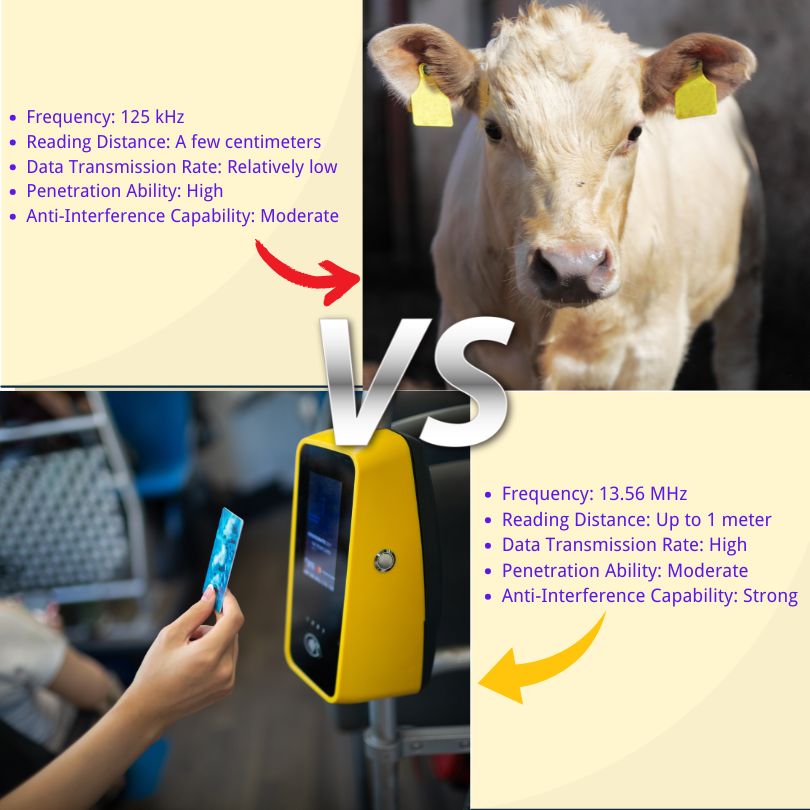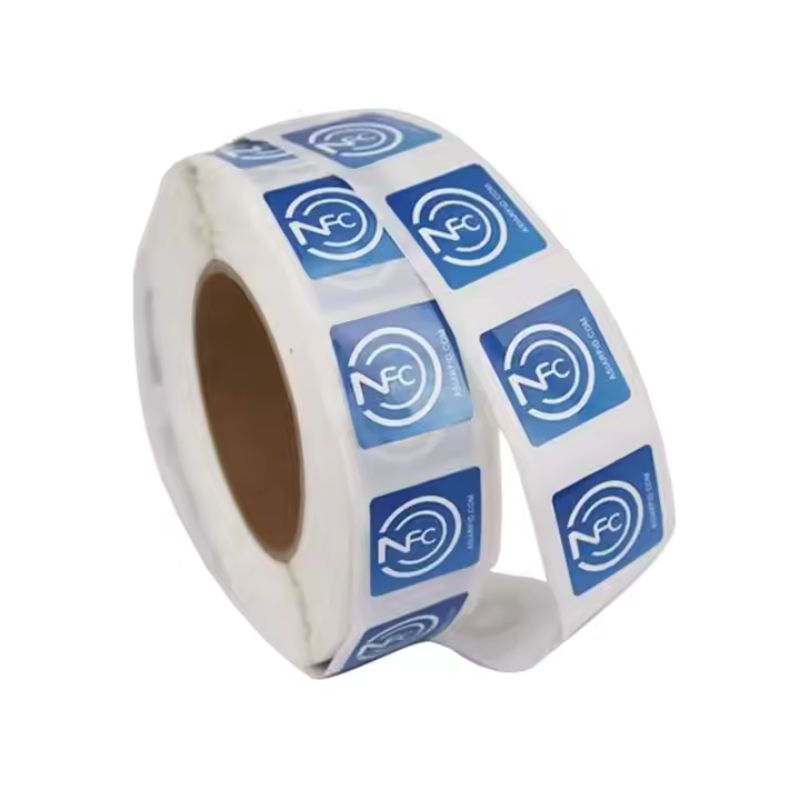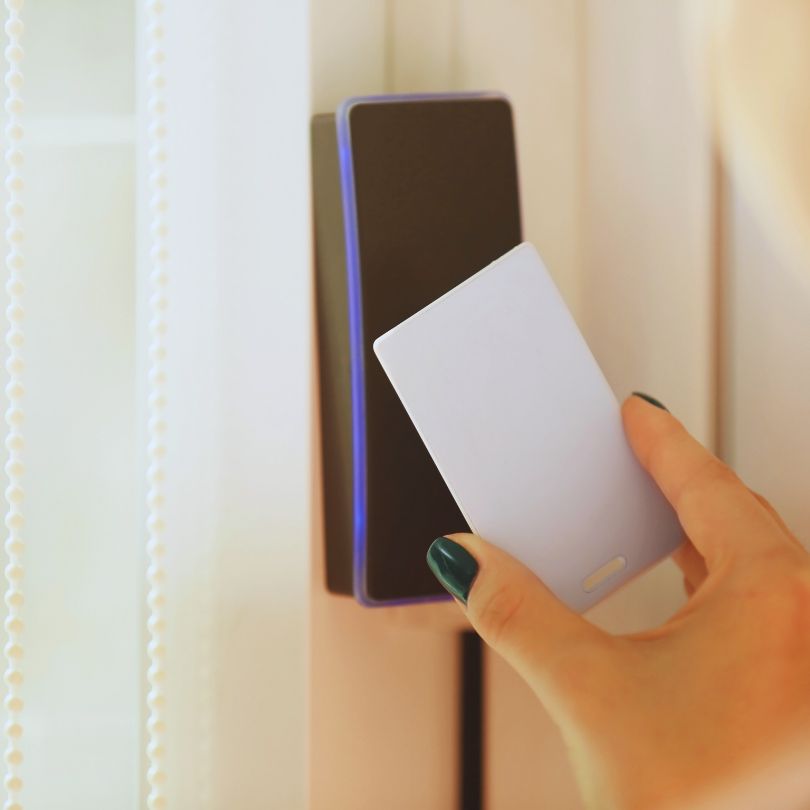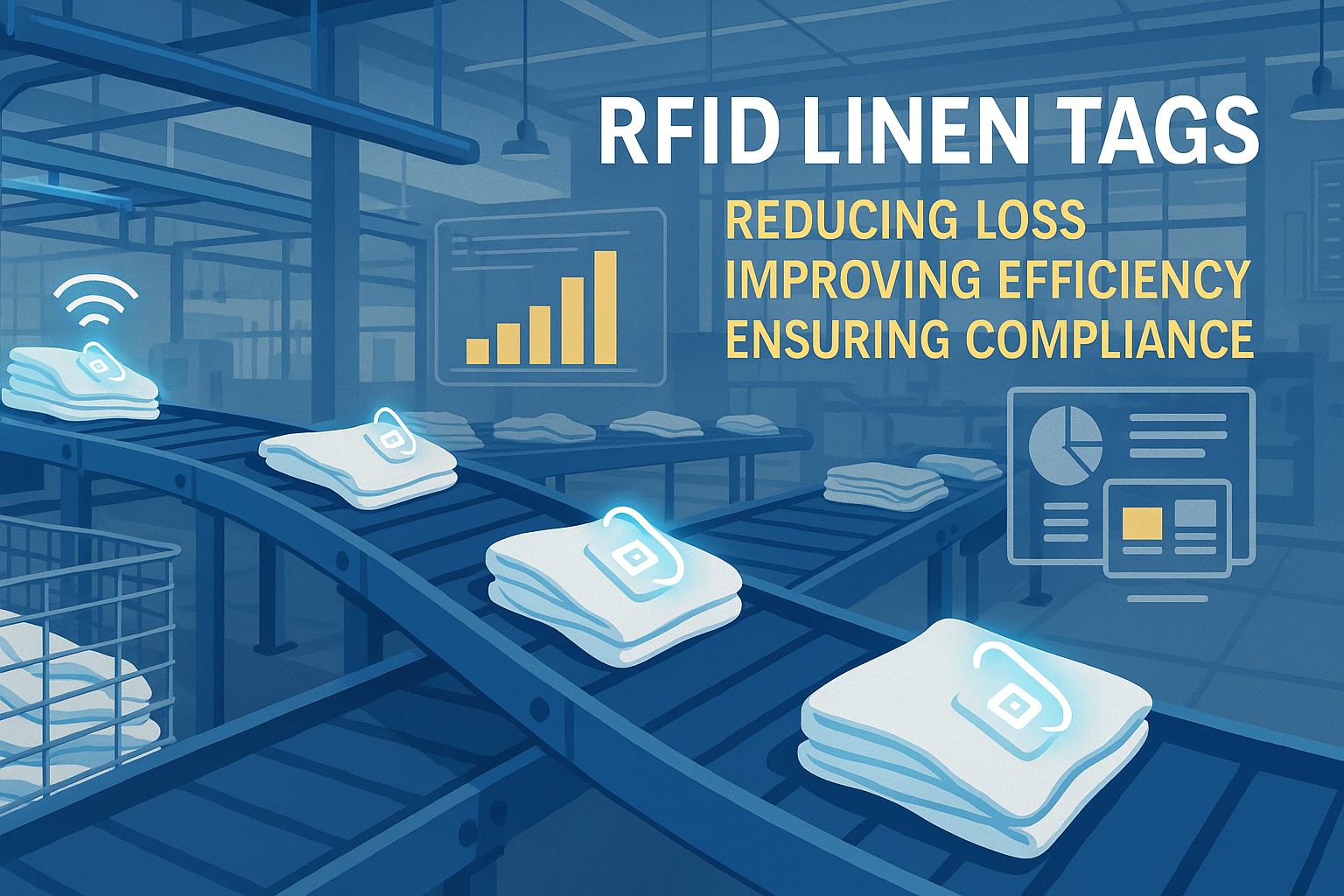
Die Unterschiede zwischen 13,56 MHz und 125 kHz RFID-Tags verstehen
Inhaltsverzeichnis
Die Unterschiede zwischen 13,56 MHz und 125 kHz RFID-Tags verstehen

Was die RFID-Frequenz wirklich bedeutet (LF vs. HF)
RFID-Systeme nutzen Funkwellen zur Kommunikation zwischen tags und Lesegeräte. Die Frequenz, die sie verwenden, beeinflusst, wie weit sie lesen können, wie schnell sie Daten senden, wie sie sich in der Nähe von Metall oder Wasser verhalten und welche Art von Daten sie speichern können.
Hier ist die Kernidee:
Niederfrequenz (LF) = 125 kHz RFID-Tags
- Kurze Reichweite
- Geringere Datenrate
- Hervorragende Leistung in der Nähe von Metall oder Flüssigkeiten
- Einfach, robust und erschwinglich
Hochfrequenz (HF) = 13,56 MHz RFID-Tags - Größere Reichweite
- Höhere Datenrate
- Erweiterte Sicherheit
- Kompatibel mit NFC und Smartphones
13,56 MHz gegenüber 125 kHz
| Besonderheit | 13,56 MHz RFID-Tags | 125 kHz RFID-Tags |
|---|---|---|
| Frequenz | 13,56 MHz (HF) | 125 kHz (LF) |
| Lesebereich | Bis zu 1 Meter | 2-10 cm |
| Datenübertragungsrate | Hoch | Niedrig |
| Leistung in der Nähe von Metall | Mäßig | Stark |
| Sicherheit | Unterstützt Verschlüsselung, gegenseitige Authentifizierung | Einfach, normalerweise keine Verschlüsselung |
| NFC-/Smartphone-Unterstützung | Ja | NEIN |
| Kosten | Höher | Untere |

Sicherheit: Ist eine Frequenz sicherer?
125 kHz RFID-Tags werden häufig in älteren Systemen verwendet und verwenden in der Regel feste eindeutige IDs ohne Verschlüsselung. Dadurch lassen sie sich mit handelsüblichen Geräten leicht klonen. Für Systeme mit geringem Risiko sind sie zwar ausreichend, entsprechen jedoch nicht den modernen Sicherheitsstandards.
13,56 MHz RFID-Tags, insbesondere MIFARE- oder DESFire-Karten, unterstützen:
- Verschlüsselung
- Gegenseitige Authentifizierung
- Sichere Speicherung
- Mehrere Anwendungen auf einer einzigen Karte
Fazit: - Verwenden Sie für geringe Sicherheitsanforderungen (wie Schließfachschlüssel, Stechuhren) weiterhin 125-kHz-RFID-Tags.
- Wählen Sie 13,56 MHz für Zugangskontrollen, Zahlungen oder jedes System, das personenbezogene Daten speichert.
NFC- und Smartphone-Kompatibilität
Wenn Ihr Projekt Telefone umfasst, funktionieren 125-kHz-RFID-Tags nicht.
Nur 13,56 MHz RFID-Tags Unterstützt NFC (Near Field Communication) – die Technologie, die bei mobilen Zahlungen, Check-ins und Tap-to-Pair-Funktionen zum Einsatz kommt.
Die meisten Smartphones können NFC-Tags mit 13,56 MHz lesen und schreiben, wodurch diese Frequenz ideal ist für:
- Digitale Tickets
- Veranstaltungs-Check-ins
- Intelligente Poster
- Kundenkarten
- Kontaktlose mobile ID
Wenn Smartphone-Unterstützung wichtig ist, ist 13,56 MHz Ihre einzige Wahl.
Anwendungsfälle aus der Praxis nach Branche
| Branche / Anwendung | 125 kHz RFID-Tags | 13,56 MHz RFID-Tags |
|---|---|---|
| Zugriffskontrolle | Einfache Zugangssysteme, ältere Türen | Sichere Zugangsdaten, moderne Ausweise |
| Öffentliche Verkehrsmittel / Fahrkartenverkauf | Nicht unterstützt | MIFARE/NFC-basierte Fahrkarten |
| Tierverfolgung | Weit verbreitet aufgrund der Gewebedurchdringung | Selten |
| Industrielle Automatisierung | Zuverlässig in der Nähe von Metall/Flüssigkeiten, robuster Einsatz | In rauen Umgebungen weniger verbreitet |
| Gesundheitspflege | Nicht ideal für die Nachverfolgung von Patienten oder Medikamenten | Besser für sichere ID- und Asset-Kennzeichnung |
| Bibliotheken / Archive | Selten | Beliebt für die Verfolgung und Ausleihe von Büchern |
| Marketing / Veranstaltungen | Nicht zutreffend | Intelligente Poster, NFC-Veranstaltungspässe |
| Fahrzeugdiebstahlschutz | Eingebettete 125-kHz-RFID-Tags in Schlüsseln/Zündschlössern | Nicht verwendet |

Wie Sie zwischen 13,56 MHz und 125 kHz für Ihr Projekt wählen
Verwenden Sie diese Checkliste, um Ihre Entscheidung einzugrenzen:
1. Sicherheitsstufe
- Benötigen Sie Verschlüsselung oder sicheren Zugriff? → Entscheiden Sie sich für 13,56 MHz.
- Risikoarmes Tracking oder einfache Identifizierung? → 125 kHz könnte ausreichend sein.
2. Umwelt
- Starke Störungen, Metall oder Flüssigkeiten in der Nähe? → 125 kHz funktioniert besser
- Sauberes Büro oder Innenraum? → Beides ist möglich; wählen Sie anhand der Funktionen.
3. Smartphone-Integration
- Möchten Sie, dass Benutzer mit ihren Smartphones scannen? → Nur 13,56 MHz unterstützt dies.
4. Budget
- 125-kHz-Tags sind in der Anschaffung günstiger.
- Aber 13,56 MHz bietet langfristig mehr Vorteile, wenn Sie bestimmte Funktionen oder Sicherheit benötigen.
Verwenden Sie immer noch 125-kHz-RFID-Tags? Aufrüsten oder bleiben?
125-kHz-RFID-Tags werden nach wie vor häufig eingesetzt in:
- Ältere Zugangskontrollsysteme
- Betrieb in der Fabrikhalle
- Kennzeichnung von Nutztieren
- Automatische Diebstahlsicherungssysteme
Aber wenn Sie es schaffen: - Mitarbeiterausweise
- Zahlungssysteme
- Mehrzweck-Ausweise
- NFC-Integration
…dann könnte es Zeit für einen Wechsel sein.
Upgrade-Pfade:
- Installieren Sie Dualfrequenz-Lesegeräte.
- Kombikarten ausgeben (unterstützt sowohl 13,56 MHz als auch 125 kHz)
- Schrittweise Einführung: Unterstützung beider Systeme während der Migration
Häufig gestellte Fragen zu 13,56 MHz vs. 125 kHz RFID
Ist 13,56 MHz dasselbe wie NFC?
Ja, NFC ist eine Art von 13,56-MHz-RFID. Die meisten Smartphones unterstützen diese Technologie.
Kann ein Lesegerät beide Frequenzen lesen?
Normalerweise nicht. Sie benötigen einen Dual-Technologie-Leser, um beide zu verarbeiten.
Welcher Tag hat eine größere Reichweite?
13,56 MHz hat im Allgemeinen eine größere Lesereichweite (bis zu 1 Meter). 125 kHz ist auf wenige Zentimeter begrenzt.
Was sollte ich für die Zugangskontrolle verwenden?
Für moderne, sichere Zugangssysteme wird 13,56 MHz dringend empfohlen.
Warum haben 13,56 MHz- und 125 kHz-RFID-Tags unterschiedliche Lesereichweiten?
Der Unterschied in der Lesereichweite ist hauptsächlich auf die Betriebsfrequenz zurückzuführen. Höhere Frequenzen wie 13,56 MHz haben eine größere Reichweite, während niedrigere Frequenzen wie 125 kHz für kürzere Entfernungen optimiert sind.
Welcher RFID-Tag eignet sich besser für metallische oder flüssige Umgebungen?
125-kHz-RFID-Tags sind aufgrund ihrer besseren Durchdringungsfähigkeit in Umgebungen mit Metallen oder Flüssigkeiten effektiver.
Haben die Kosten für RFID-Tags Einfluss auf die Auswahl?
Ja, 125-kHz-RFID-Tags sind im Allgemeinen kostengünstiger und daher eine geeignete Option für kostenbewusste Anwendungen. Bei der Auswahl sollten jedoch auch Leistungsanforderungen und Anwendungsumgebungen berücksichtigt werden.
Wichtige Standards und Chip-Typen
13,56 MHz (HF)
- ISO/IEC 14443: Wird in kontaktlosen Karten verwendet (MIFARE, DESFire)
- ISO/IEC 15693: Größere Reichweite, Verwendung in Bibliotheken, Logistik
- ISO 18000-3: Nachverfolgung auf Artikelebene
125 kHz (LF)
- Proprietäre Formate, oft mit fester ID (z. B. EM4100, HID Prox)
- Wird hauptsächlich in älteren Systemen und einfachen Anwendungen verwendet.
Abschließende Erkenntnisse
Wenn Sie sich noch nicht sicher sind, welchen Weg Sie einschlagen sollen, finden Sie hier eine Zusammenfassung:
Verwenden Sie 125-kHz-RFID-Tags für:
- Raue Bedingungen (Metall/Flüssigkeit)
- Anwendungen mit geringer Sicherheit
- Budgetbewusste Bereitstellungen
- Altsysteme
Verwenden Sie 13,56-MHz-RFID-Tags für:
- Mobile/NFC-Unterstützung
- Sicherer Zugang und sichere Bezahlung
- Mehrzweckkarten
- Zukunftsfähige Systeme
Beide haben ihre Berechtigung – aber Sie sollten Ihre Wahl anhand des Anwendungsfalls treffen und nicht nur aufgrund der Kosten oder Gewohnheiten.
Kommentare
heiße Produkte

Was ist RFID-Abfallmanagement?
Stellen Sie sich eine Stadt vor, in der jeder Mülleimer spricht – nicht im wörtlichen Sinne, sondern über einen winzigen Chip, der dem System mitteilt, wann er voll ist, wann er geleert wurde und wohin er gebracht wurde. Genau das leistet heute die RFID-Abfallwirtschaft.

Was sind Schraubendichtungen und ihre Anwendungen? | Vollständiger Leitfaden
Im globalen Handel und in der Logistik spielen Bolzenplomben eine entscheidende Rolle bei der Gewährleistung der Frachtsicherheit und der Einhaltung von Vorschriften. Diese kleinen, aber leistungsstarken Geräte sind so konzipiert, dass sie Schiffscontainer, Anhänger und Frachttüren mit einem manipulationssicheren Mechanismus verriegeln.

Was ist eine RFID-Kartenschutzhülle? Vorteile, Anwendungsfälle und Kaufberatung
Die RFID-Technologie (Radio Frequency Identification) ist allgegenwärtig: in Ihren Kreditkarten, Ausweisen, Fahrkarten, Hotelzimmerschlüsseln und vielem mehr. Sie bietet Schnelligkeit und Bequemlichkeit, öffnet aber auch die Tür für eine neue Art des digitalen Diebstahls, das sogenannte "Skimming". An dieser Stelle kommt ein RFID-Kartenschutz ins Spiel.

RFID-Armbänder für Veranstaltungen: Großeinkaufsleitfaden für Veranstalter
RFID-Armbänder für Veranstaltungen werden zur bevorzugten Lösung für Organisatoren, die einen schnelleren Einlass, Betrugsprävention und bargeldlose Zahlungen bei Konzerten, Festivals und Sportveranstaltungen benötigen. Im Gegensatz zu Papiertickets oder QR-Codes verwenden diese intelligenten Armbänder eingebettete Chips, um den Zugang zu rationalisieren, Transaktionen zu sichern und das Erlebnis der Gäste zu verbessern.

Wie RFID-Etiketten an der Windschutzscheibe die Fahrzeugzugangskontrolle und Mautsysteme verbessern
In der heutigen schnelllebigen Welt muss die Fahrzeugidentifizierung schnell, sicher und berührungslos sein. Ein RFID-Tag an der Windschutzscheibe bietet genau das - eine zuverlässige Möglichkeit, die Mauterhebung, das Parken und die Zufahrtskontrolle zu verwalten, ohne die Fahrzeuge anzuhalten.

Die Vorteile von RFID-Wäscheetiketten in der gewerblichen Wäscherei
Die Verwaltung der Wäsche in Krankenhäusern, Hotels oder großen Wäschereien ist eine große Aufgabe. Jeden Tag werden Tausende von Laken, Handtüchern und Uniformen gewaschen, sortiert und zurückgeschickt. Aber Probleme wie verlorene Wäsche, Sortierfehler und manuelles Zählen können Unternehmen viel Geld kosten. So können mittelgroße Hotels durch fehlende Wäsche jedes Jahr über $200.000 verlieren.
Hier kommen die RFID-Wäscheetiketten ins Spiel.
Schlagwörter
VERWANDTE BLOGS

Was ist RFID-Abfallmanagement?
Stellen Sie sich eine Stadt vor, in der jeder Mülleimer spricht – nicht im wörtlichen Sinne, sondern über einen winzigen Chip, der dem System mitteilt, wann er voll ist, wann er geleert wurde und wohin er gebracht wurde. Genau das leistet heute die RFID-Abfallwirtschaft.

Was sind Schraubendichtungen und ihre Anwendungen? | Vollständiger Leitfaden
Im globalen Handel und in der Logistik spielen Bolzenplomben eine entscheidende Rolle bei der Gewährleistung der Frachtsicherheit und der Einhaltung von Vorschriften. Diese kleinen, aber leistungsstarken Geräte sind so konzipiert, dass sie Schiffscontainer, Anhänger und Frachttüren mit einem manipulationssicheren Mechanismus verriegeln.

Was ist eine RFID-Kartenschutzhülle? Vorteile, Anwendungsfälle und Kaufberatung
Die RFID-Technologie (Radio Frequency Identification) ist allgegenwärtig: in Ihren Kreditkarten, Ausweisen, Fahrkarten, Hotelzimmerschlüsseln und vielem mehr. Sie bietet Schnelligkeit und Bequemlichkeit, öffnet aber auch die Tür für eine neue Art des digitalen Diebstahls, das sogenannte "Skimming". An dieser Stelle kommt ein RFID-Kartenschutz ins Spiel.




